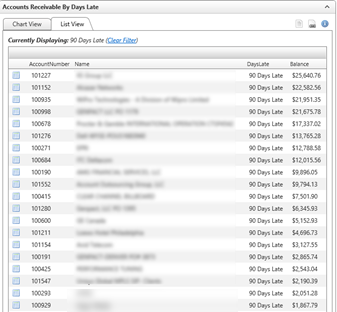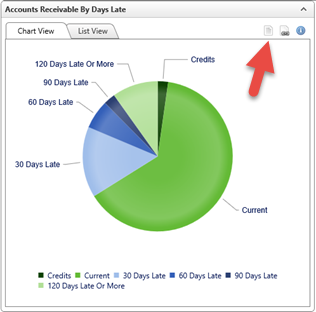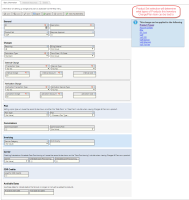2015-06 Punisher Release Notes
Overview
The Punisher Release focused on finalizing the Dashboard and Charting functionality started in Odin. This phase of development allows users to "drill down" from a chart to the underlying detail records. The goal is to enable more effective work flows. This release also included Chart / List features that allow for a more polished user experience.
33859 - Chart: Drill into List View from Chart series
Dashboard Charts now support the ability to click a Chart Series (pie slice, bar, line, etc) and "drill into" the list view to show the details that make up that section of the chart. This functionality is designed to help users focus on the most important tasks to be accomplished.
For example, a Chart can be setup to visually display Open Orders by SLA Goals. Provisioning users can then drill into the Orders that are past due, due today, or due at some interval in the future by clicking the desired Chart Series Item.
Another example for Accounting / Collections users: The Pie Chart below shows the Accounts Receivable by Days Late. Clicking a slice of pie will open the List View filtered to the desired set of accounts (90 Days Late in this example). The current filter is displayed above the grid. Clicking the "Clear filter" link will return the user to the Chart View.

|

|
The current filter is displayed above the grid. Clicking the "Clear filter" link will return the user to the Chart View.
Administrative Setup
In order to use this feature, the report must have a chart setup. The List SQL must include a special placeholder in the Where clause. This placeholder must be entered exactly as shown inside the quotes: "and ~ChartDrillDownSQL~".
The Flex Report Admin screen has a new "Chart Drill Down SQL" field which is used to define the placeholder replacement values. Two special fields can be used in addition to any standard SQL. These are:
- {%Category%} - The Category variable is the Value of one of the fields specified inside the group by clause of the Chart SQL. For example, the Category variable for a chart showing counts by Orders.Status would be values such as "Received" or "Assigned".
- {%SeriesName%} - The SeriesName variable is a Field Name as defined in the Chart Series Admin Grid. For example, the Series variable for a chart showing counts by Orders.Status, would be the Field Name "Status" regardless of the value clicked.
A Example of both Category and SeriesName:
On a Chart showing the last 3 months of transactions grouped by Transaction Type (Payments, Credits, Debits, Charges), the "Chart Drill Down SQL" would be: Month = '{%Category%}' and {%SeriesName%} > 0
Clicking the Payments column for the month of May would result in: "Month = 'May' and Payments > 0"
For more help setting up this feature please contact your account manager.
35100 - Chart: General Improvements
The available Dock Zones has been expanded. Users can now target the following:
- Top: This is full screen width at the top of the screen
- Left or Right - These Zones are in the center of the screen and each use 1/2 of the screen width
- Bottom - This is full screen width at the bottom of the screen
Any unused Dock Zone will be suppressed and not use any screen real estate.
34552 - Chart: Implement Hidden Column and Column Format Options
The new Chart widgets can use many of the features that are available in the Flex Report interface. These features include the ability to add hidden fields and in line formatting.
You can add a comma delimited list of fields in the Hidden Fields text box on the Report tab of the Flex Report Administration page.
You can also add field formatting to the SQL text box on the Report tab using the format ColumnName|{X}. The most common formatting options are:
- ColumnName|{c} to format the column as currency.
- ColumnName|{d} to format the column as date.
34553 - Chart: "Run as Flex" Option
The dashboard grids are meant to provide users with a limited set of records to help focus on work task that should be addressed in the near future. At times, it may be desirable to see and/or export the full set of records that are used to generate the Chart data. To accomplish this, users can click the  "Run as Flex Report" icon in the upper right corner of any Chart Control. This will navigate the user to the Flex Reports screen where they can run the report and use all reporting features (sort, filter, export, etc).
"Run as Flex Report" icon in the upper right corner of any Chart Control. This will navigate the user to the Flex Reports screen where they can run the report and use all reporting features (sort, filter, export, etc).

35112 - Chart Grid: UserType specific Redirects
Some changes have been made to how charts provide links to the relevant records in the system. System defined Link Types and Custom URL / Links are both supported. The new Link Type field is used to specify the desired behavior. The current options are:
- Customer (requires a CustomersKey column)
- Order (requires an OrdersKey column in the)
- Ticket (requires a TroubleTicketsKey column)
- Custom Location (requires a LinkTemplate column and other columns as specified by the LinkTemplate)
Custom Location:
This option is available so that a chart can link to any URL and is best illustrated with an example. Setting the SQL of a chart equal to the following:
select 'https://www.somewhere.com/myaccount?{%AccountNumber%}' as LinkTemplate, AccountNumber from Customers
will, for a customer with AccountNumber of '12345678', use the LinkTempate and AccountNumber in the table row to create a link to 'https://www.somewhere.com/myaccount?12345678'.
35135 - Major Release Notification Development
![]()
Users with Maintenance module access will now see an Upcoming Release menu option when new major system versions are ready for release.
Clicking the menu item will take the user to the System Releases page where they can review upcoming release notes and database changes.
See the great charting improvements described above :)
Integrated Products - Enhancements & Bug Fixes
30105 - Add Activation Charge Trans/Serv on Charges & Plans Inventory Admin Screen
In order to provide clients with more granular control over taxing, separate Taxing Transaction and Service Types can now be specified for activation charges (as opposed to interval charges) on the charges and plans inventory screen.
Prior to this change, activation charges used the same Taxing Transaction and Service Types as the interval charge. These new fields are required and have been back filled to ensure taxing will continue to behave as before.
API Integrations - Enhancements & Bug Fixes
33169 - TBS Orion Network Performance Monitor Integration
TBS has an integration into the Orion Network Performance Monitor.
To enable this integration, a Orion Network Resource must be setup by a system administrator. The administrative page can be found from the menu via Utilities -> System Administration -> Network Resources. The required fields are:
- Description
- Network Resource Type of "Orion"
- Host URL in the following format: http://<orion url>/Login.aspx?AccountID={%USERNAME%}&Password={%PASSWORD%}
Once enabled, each Customer in TBS must have their individual Orion User ID and Orion Password set on Custom Fields. Select the Account Settings Tab -> Custom Fields Tab from the Customer screen.
Internal Users will see an Orion Portal Tab on the customer screen. If the Orion User ID and Password have been set on Custom Fields, this tab will be enabled. Clicking the tab will open the Orion Site in a new window. If the User ID and Password are not set, the tab will be disabled and display a message indicating why.
Customer Portal Users will see an Orion Network Performance Monitor under the Services Menu ONLY if the Orion User ID and Password has been set on Custom Fields by an Internal User.
